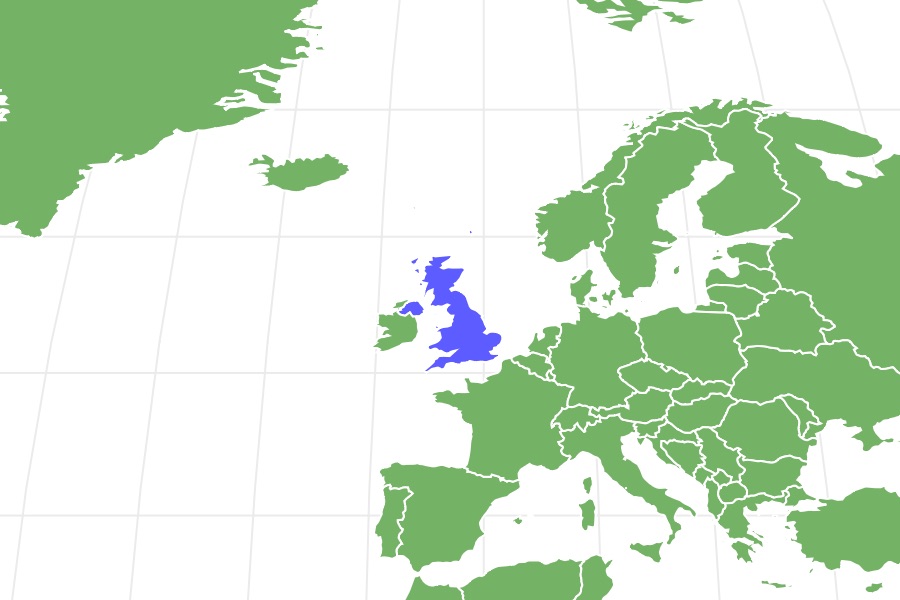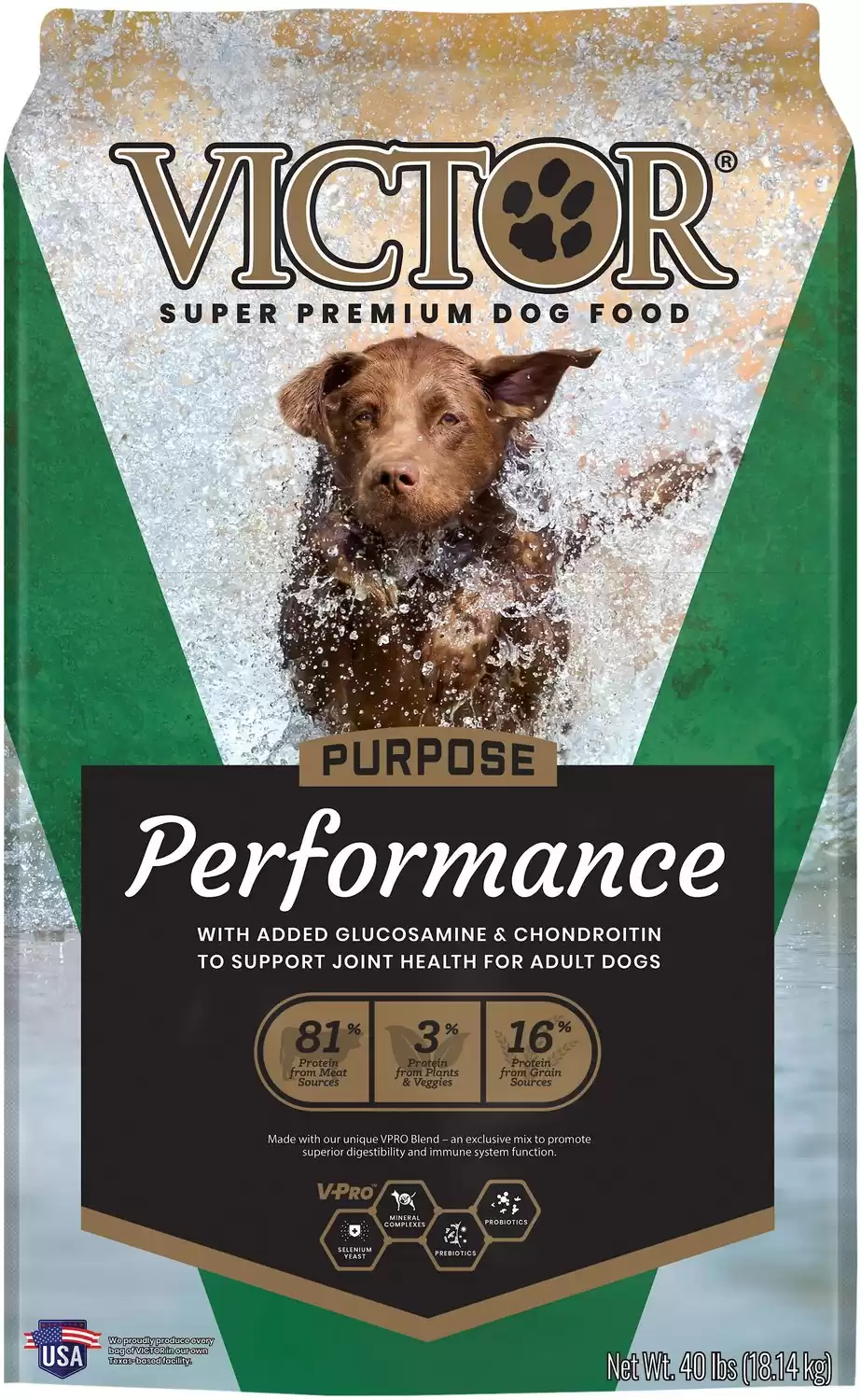Greyhound
Canis Lupus
Extremely fast and athletic!
Advertisement
Greyhound Scientific Classification
- Kingdom
- Animalia
- Phylum
- Chordata
- Class
- Mammalia
- Order
- Carnivora
- Family
- Canidae
- Genus
- Canis
- Scientific Name
- Canis Lupus
Read our Complete Guide to Classification of Animals.
Greyhound Conservation Status
Greyhound Facts
Greyhound as a Pet:
- General Health
- Energy Level
- Shedability
- Trainability
- Intelligence
- Tendency to Chew
- Size
- Family and kid friendliness
- Yappiness / Barking
- Silent
- Separation Anxiety
- Moderate
- Preferred Temperature
- Warm climate
- Exercise Needs
- Moderate
- Friendly With Other Dogs
- Moderate
- Pure bred cost to own
- $2,500-15,000
- Dog group
- Sporting
- Male weight
- 60-88 lbs
- Female weight
- 55-75 lbs
This post may contain affiliate links to our partners like Chewy, Amazon, and others. Purchasing through these helps us further the A-Z Animals mission to educate about the world's species.
View all of the Greyhound images!
The greyhound is the fastest breed of dog, and retired racing greyhounds make for calm and sweet pets.
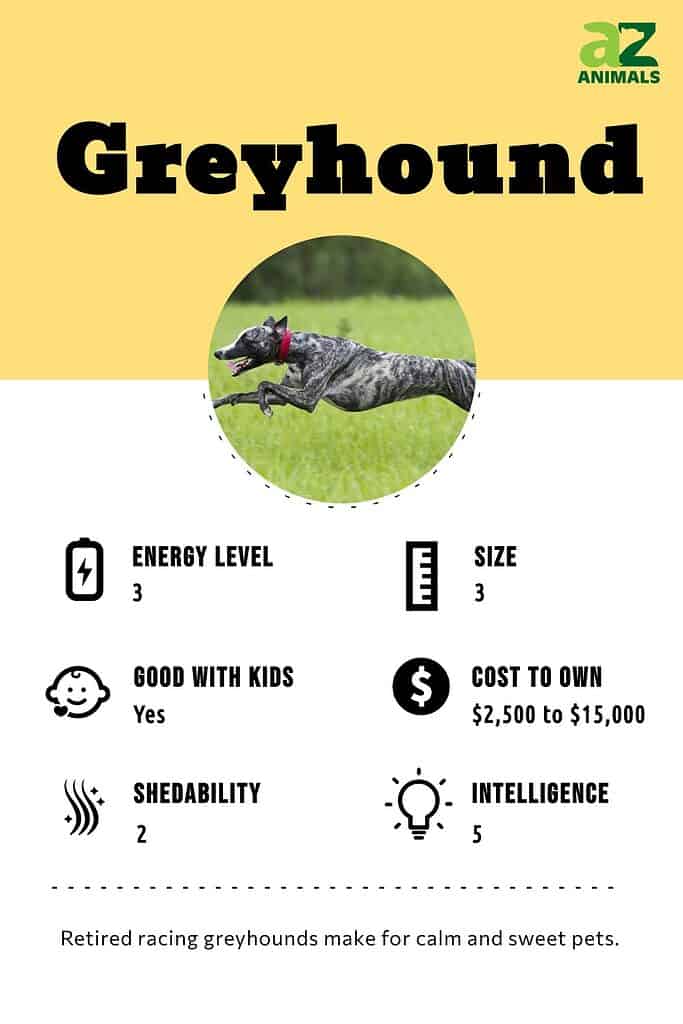
The greyhound has the highest percentage of fast-twitch muscle of any breed. In spite of this reputation, retired racing greyhounds make for calm and sweet pets. It is also called the English greyhound to avoid confusion with the Italian greyhound. Since its breed registration in 1885 by the American Kennel Club, it has enjoyed a following as a friendly, noble sporting show dog and pet.
See all of our expert product reviews.
History and Origins
The breed is a hunting type and a sighthound whose ancient remains were discovered in modern Syria and dated 4,000 years ago. Originally, however, it was used for hunting desert wildlife by the Egyptian pharaohs 5,000 years ago and depictions of the dogs have been found in their tombs. It has a history in coursing of deer, foxes, and hare, and racing and companionship in England, Great Britain, and the British Isles.
Greyhounds feature in Greek and Roman mythology and are the only dog mentioned in the Bible. They have long been associated with royalty and aristocracy. During the Dark Ages, they nearly became extinct due to famine but were saved by priests, who bred them for the nobility. King Canute, who ruled England from 1016 to 1035, enacted a law lasting almost 400 years that owning a greyhound was a right exclusive to noblemen, who often used them in hunting and coursing.
Due to their speed and agility, the breed was used for dog races, with greyhound racing reaching its peak in the 19th century in England and the 20th century in America. Owing to the cruelty of greyhound racing, including overbreeding, these days it is legal in only a handful of countries and a few states in the U.S.

Greyhounds were revered in Ancient Egypt and appear on pharaohs’ tomb walls.
©matrioshka/Shutterstock.com
Health and Entertainment for your Greyhound
See all of our expert product reviews.
3 Pros and Cons of Owning Greyhounds
| Pros! | Cons! |
| They don’t need much exercise. They only need a 20-30 minute walk each day. | Hyperactive and destructive tendency If the puppies don’t get enough play with the proper toys, they will mouth on various things in the house. |
| They get along with everyone. They enjoy getting to know adults, children, and other pets. | Sensitive skin They need soft bedding to sit and sleep in. And since they’re vulnerable to extreme temperatures, they need to live indoors, especially when it’s cold. They also need to avoid sunburn. |
| They don’t trigger allergic reactions as much. They have no undercoats, unlike other dogs. | Familiar vet Their vet needs to know the breed to properly anesthetize them and treat their unique issues. |

©Eric Isselee/Shutterstock.com
Size and Weight
This dog is tall, slim, graceful, and a smooth-coated large dog with powerful, long legs under a deep chest, flexible spine and slender build. They have a height of 28-30 inches for males and 27-28 inches for females. Males weigh 60-88 lbs and females weigh 55-75 lbs. They both weigh on average about 70 lbs. Most greyhounds in family homes today are adopted as adult racing dogs. They are considered adults at 18 months.
| Height | Weight | |
| Male | 28-30 inches | 60-88 lbs |
| Female | 27-28 inches | 55-75 lbs |
Common Health Issues
Greyhounds tend to be healthy and to live long lives of 10-14 years. However, there have been some cases of greyhounds developing esophageal achalasia, gastric dilatation volvulus (also called bloat), gastric torsion, heart and eye conditions, osteosarcoma, and corns on the paw pads. There is also a condition called greyhound neuropathy. They can develop Alabama rot if exposed to E. coli. If they are on hard surfaces, they develop skin sores. Flea collars, flea spray, and other insecticides are not safe to use on them. If they are outside, they will have more health issues from exposure to extreme heat or cold, though they tolerate heat better than cold.
Some racing greyhounds develop an arched back — while they run, they extend their long legs and stretch their spines for a better stride to cover more ground in less time. An arched back makes it impossible for them to do so, although some dogs can run very fast. Recommended health tests for the breed are an ophthalmologist evaluation, a greyhound polyneuropathy NDRG1 DNA test, and a cardiac exam. In sum, common health issues with this breed are:
- Dangerous conditions such as bloat, gastric torsion, or esophageal achalasia
- Heart and eye conditions
- Osteosarcoma
- Greyhound neuropathy
- Sensitive skin
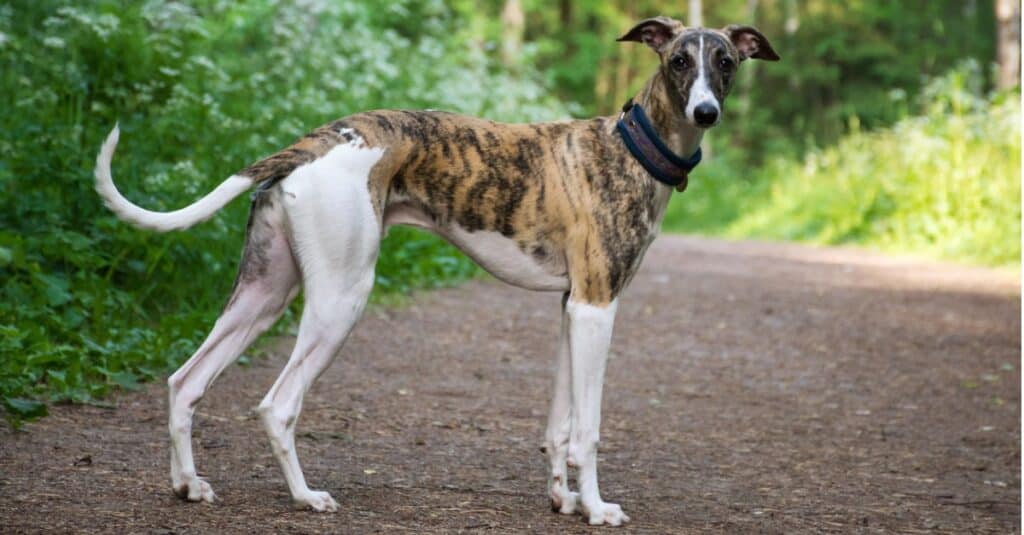
If greyhounds are outside, they have more health issues from exposure to extreme temperatures.
©iStock.com/Natalia Timchenko
Temperament and Behavior
Notably, Greyhounds are docile, quiet, gentle, and loving pets. They each have their own personality, with different traits and behavior depending on whether they were purely show or working dogs. Although many adopted greyhounds are retired racing dogs, they adjust very well as adults to their new homes. They don’t tend to bark or howl, but they are mistrustful of strangers. When they are not sprinting outside, they are couch potatoes at home, mostly relaxing or sleeping for 18 hours a day. However, it is difficult for them to be left alone for several hours, as they need a lot of attention and care. That’s because they enjoy being around people and other pets.
As puppies, they are more demanding than adults, with a need for playtime of 1 to 2 hours a day. Likewise, they need chew toys to learn not to mouth on people.
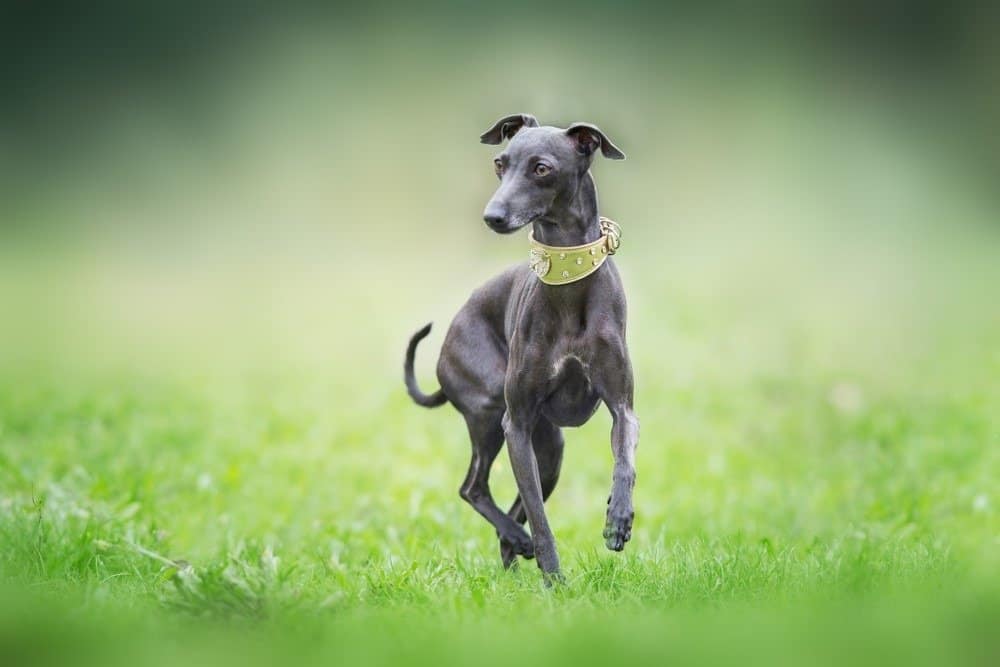
Greyhounds are known to be docile, quiet, and gentle dogs.
©Kwadrat/Shutterstock.com
How To Take Care of Greyhounds
The most important decision in adopting a greyhound is whether it should be a puppy or an adult because they are different in their needs and behavior. From there, new pet owners can learn about how to care for these dogs at various ages. The breed also has unique health factors that must be considered.
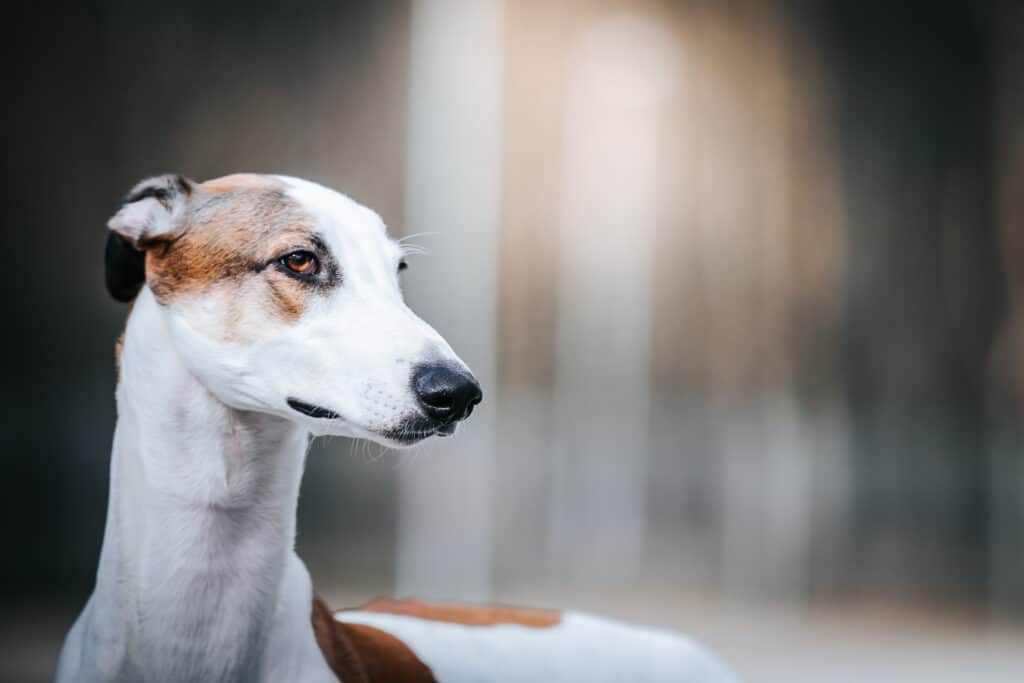
Be aware of greyhounds’ unique health factors before adopting.
©Eve Photography/Shutterstock.com
The Best Dog Food for Greyhounds
Most importantly, greyhounds demand a diet higher in fat, calories, and protein than some other dogs. More specifically, they need high-quality dog food for their age.
Also, since this breed can be prone to heart issues, stay educated about the link between legumes in dog food and heart failure, and think about looking for legume-free dog food.
At first, puppies enjoy puppy kibble and pureed meat. Later, to meet the dietary needs of adults, feed them a mixture of dry food and chopped meat. In particular, they need 250-300g of meat a day. Like other pets, you should remember what human foods are safe for them to eat. Some examples of greyhound-safe fruit are bananas, apples, oranges, and watermelons. Also, vegetables they can eat are carrots, green beans, zucchini, cucumber, and cooked potato. Additionally, they can eat rice and pasta.
In our opinion at A-Z Animals, Victor Super Premium Dog Food – Performance Dry Dog Food – 26% Protein is the best dog food for Greyhounds.
With beef and chicken, this recipe delivers vital taurine that keeps the heart ticking and the eyes sharp. It’s expert-formulated with amino acids, omegas, and probiotics for immune system defense and balanced skin.
You can buy Victor Super Premium Dog Food on Chewy or Amazon.
- 81% meat protein with premium-quality beef, chicken and pork meals
- Ideal for sporting pups and those with high physical demands
- Contains glucosamine and chondroitin for long-term joint health
- Fortified with vitamins, minerals, essential fatty acids, protein and amino acids
- Promotes digestion and immune health
Best Greyhound Insurance
The best insurance for your greyhound is a plan that allows them to see any vet, emergency clinic or specialist in the country. Importantly, it should have unlimited or no restrictions on coverage. Also, keep in mind that some insurance companies have exclusions for performance dogs.
Maintenance and Grooming
This breed’s short coat goes through light seasonal shedding. It needs no more than a monthly bath and weekly rubdown with a damp cloth or grooming glove. Secondly, nails should be trimmed and ears cleaned regularly. Finally, you should brush their teeth every day with a special toothpaste formulated for dogs.
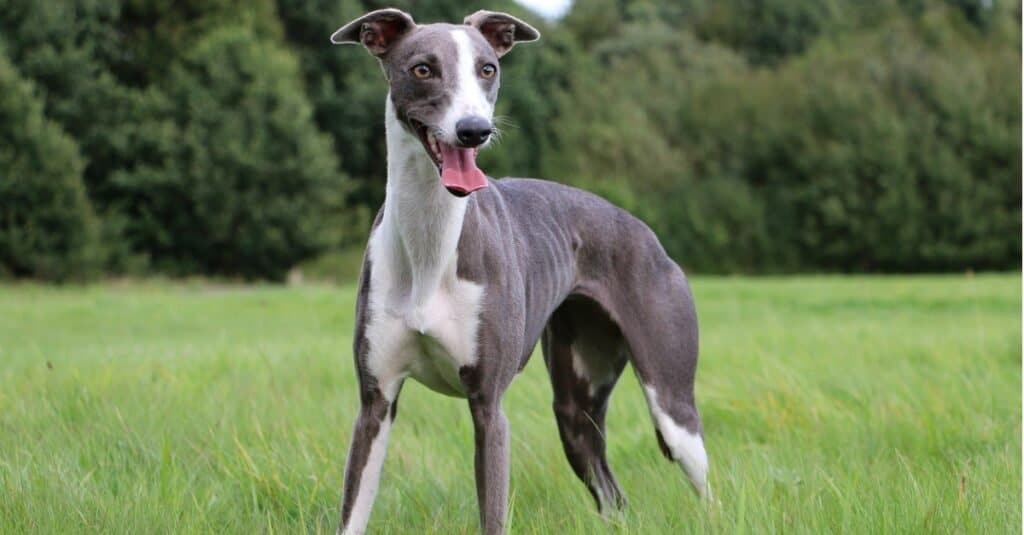
Greyhounds experience light seasonal shedding and only need a bath about once a month.
©iStock.com/BiancaGrueneberg
Training
Greyhounds are playful and have a lot of wanderlust, but they are very smart and easy to train as adults. As puppies, they are more difficult to train since they have difficulty with recall. Like other sighthounds, they have a very strong prey drive and therefore tend to give chase, being able to see far ahead. When you practice letting them go off-lead in a safe area, they will remember to come back. It becomes easier as they get older.
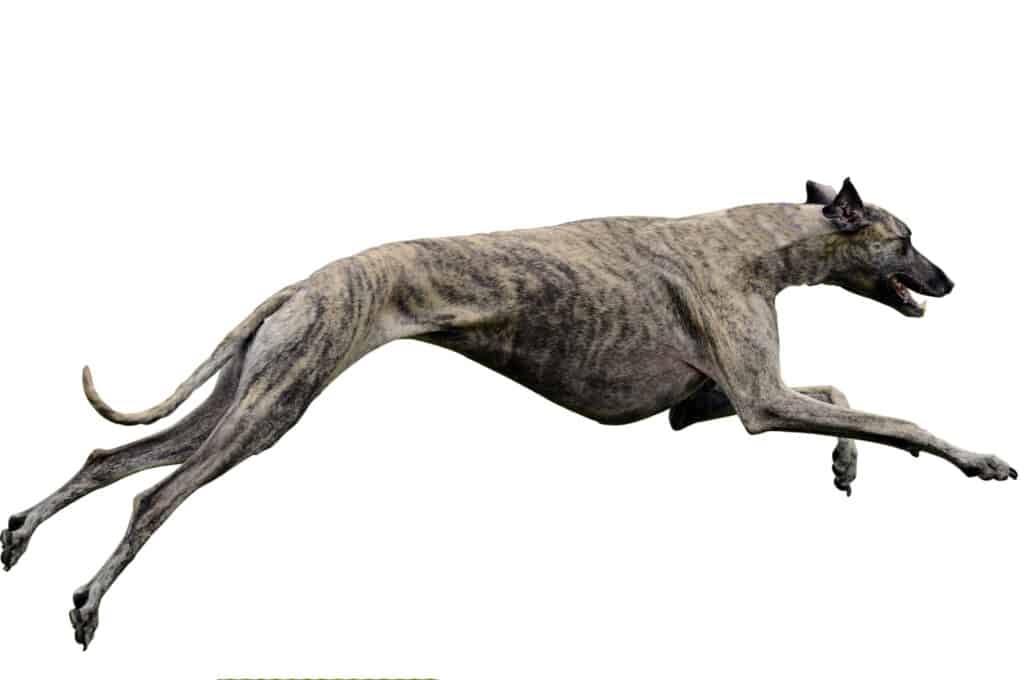
Greyhounds have an extremely strong prey drive and tend to give chase.
©Henri Faure/Shutterstock.com
Exercise
Greyhounds enjoy sprinting, with an average high speed of 45 mph. Part of their exercise is mental stimulation, so they could enjoy games or hidden treats. Other than a daily walk, they need an additional 30-40 minutes of exercise each day. They do well living in apartments if they get to be walked. If there is no yard, they will require more frequent walking. To burst off excess energy, greyhounds sprint in the backyard or through the house. Walk them in the early morning and evening to avoid sunburn, and wait an hour after feeding them before playing to avoid bloat or torsion.
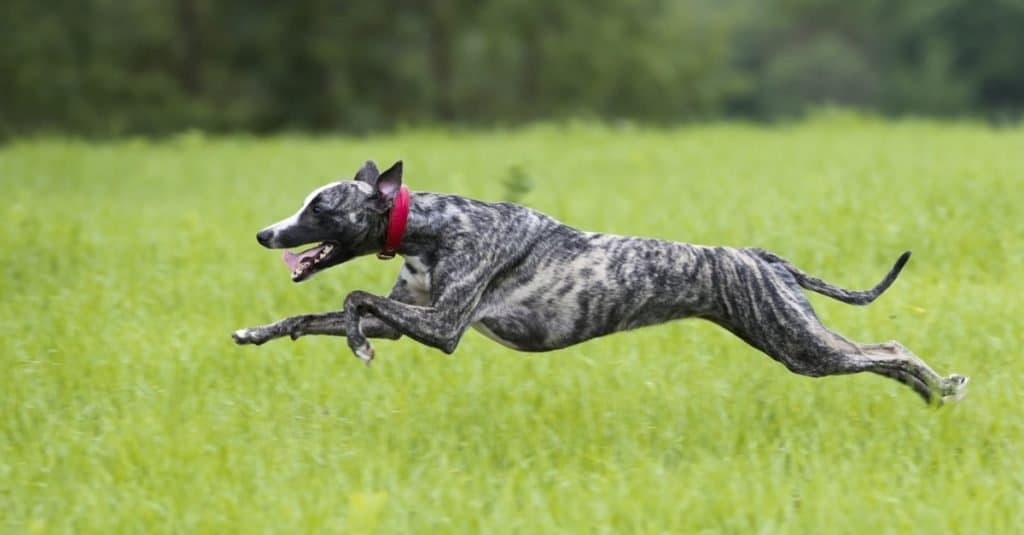
Greyhounds love sprinting and can reach an average high speed of 45 mph.
©Liliya Kulianionak/Shutterstock.com
Puppies
Puppies are born in litters of 1-12. Like most breeds, during puppyhood greyhounds express mouthiness and the tendency to chew on, nip, or play-bite. Mouthy dogs tend to use their mouths to hold or “herd” humans, so they need to learn to redirect to chew toys. Like other mouthy breeds, greyhounds love to play fetch, and they also enjoy chewing on stimulating and rewarding toys stuffed with kibble or treats. This breed needs a lot of attention and training during puppyhood.
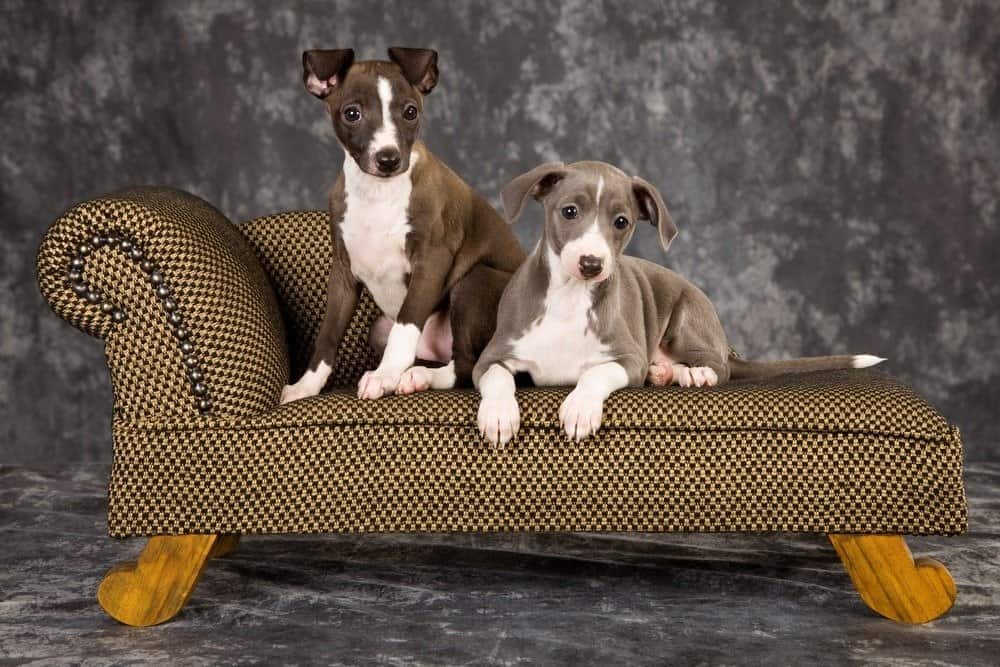
Greyhound puppies require a lot of attention and training.
©Linn Currie/Shutterstock.com
Greyhounds and Children
Greyhounds need to be socialized from a young age with other animals and children. Although very people-oriented, the breed prefers quiet and soft-spoken families rather than a family that has very young children. Their skin tears easily, making it difficult for them to be around rowdy toddlers. Rather, they are independent while playing, being more self-motivated than other hunting breeds that require direction.
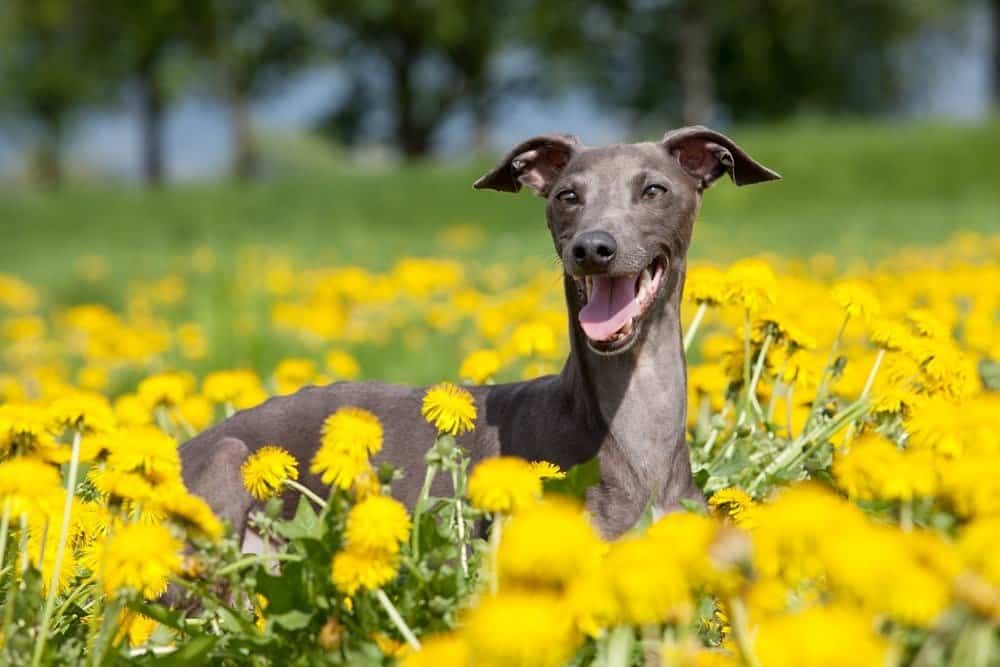
Although very people-oriented, greyhounds are independent while playing.
©Lenkadan/Shutterstock.com
Types of Greyhounds
The English greyhound belongs to the sighthound group, which includes other dogs that carry the greyhound name. These types of greyhounds, such as the Italian Greyhound and Scottish Greyhound, are separate breeds closely related to the English greyhound in appearance, temperament and traditional use as a hunting dog.
- Italian Greyhound: A miniature version of the English greyhound, the “Iggy” has a more slender build and weighs no more than 15 pounds when fully grown. Bred to be more of a lap dog than a hunting dog, it’s believed they date back to the Roman Empire and were considered a status symbol during the Renaissance. You can find out more about the differences between these breeds here.
- Russian Greyhound: Known also as the Russian Wolfhound and the Borzoi, this wavy-haired breed is larger than a standard greyhound, and may grow as tall as 33 inches and weigh up to 100 pounds. Their size means they can suffer health issues such as arthritis, hip and elbow dysplasia, and heart disease, and their average lifespan of 12 years is shorter than other breeds.
- Persian Greyhound: More commonly known as the Saluki, the Persian Greyhound is one of the oldest known dog breeds. They can be traced back to 7000 B.C. and were favorites of Egyptian pharaohs. Used as a hunting hound by royalty, they are among the fastest dogs in the world. They have longer, coarser fur than other greyhounds and their silky ears hang lower. Check out what other ways they differ here.
- Spanish Greyhound: Often called the Spanish Sighthound, or Galgo Español, the Spanish Greyhound has a long lineage, appearing on Egyptian tombs and evidence recording their presence in Spain in 100 A.D. Developed to hunt hares, they are smaller and lighter than English greyhounds, and have two coat types (smooth and rough).
- Scottish Greyhound: Originally bred to hunt and course red deer in the Scottish Highlands, these dogs are also known as Scottish Deerhound and are closely related to the Irish Wolfhound. They are a large, heavy-boned hound breed with a wiry coat and can weigh in up to 110 pounds and grow as tall as 32 inches at the shoulder.
- Arabian Greyhound: Also known as the Sloughi, these greyhounds were first bred by the Bedouin and Berber tribes in North Africa and are commonly found in Morocco. While greyhounds are generally many different colors, these dogs are usually one shade of grey or tan. As they are considered louder than other greyhounds, they are used in Africa as guard dogs.
- Afghan Greyhound: Better known as the Afghan Hound, this breed is famed for its long flowing coat of silky hair. It is said by some to be the oldest purebred dog in the world and predates written history. First bred as a hunting dog capable of withstanding the cold temperatures of mountainous Afghanistan, they now regularly feature in dog shows.
- Whippet: Bred to be a smaller version of the English greyhound, reaching up to 22 inches in height, Whippets grew popular with coal miners in Northern England, where they were used in amateur racing competitions and nicknamed the “poor man’s racehorse.” They are known to have the fastest acceleration time among dogs. They’ll want to jog with you, while the greyhound would rather cuddle. Read more about the key differences between the breeds here.

Whippets are similar to greyhounds but smaller and more active.
©Liliya Kulianionak/Shutterstock.com
Famous Greyhounds
- General George A. Custer was famous for his love of and ownership of greyhounds. He traveled with about 40 hounds of various coursing breeds.
- The United States’ 19th President, Rutherford B. Hayes, owned a greyhound named Grim.
- Mick the Miller is the most famous racing greyhound in Great Britain. He became an icon of dog racing in spite of his short three-year career, winning 19 races in a row. After his retirement, he became a feature of films and social events as a sports dog hero.

General George A. Custer was known for his love of and ownership of greyhounds.
©iStock.com/Photography by Adri
Popular Names for Greyhounds
The most popular names for greyhounds refer to their speed. For either sex, the top five names are:
- Comet
- Jet
- Dash
- Turbo
- Shadow
Top names for male greyhounds are:
- Jack
- Finn
- Charlie
- Cooper
- Buddy
Top names for female greyhounds are:
- Luna
- Bella
- Lucy
- Penny
- Molly
Greyhound FAQs (Frequently Asked Questions)
How fast can a greyhound run?
A greyhound can reach an average race speed that exceeds 40mph and a full speed of 43mph in 98 feet. It can travel at about 68feet/second for the first 820 feet of a race.
Are greyhounds good family dogs?
Yes, they are excellent with adults, children, and even other pets.
Are greyhounds high-energy dogs?
Outside of their exercise periods, greyhounds are known for being “45mph couch potatoes.” They are not high-energy dogs. Like most other dogs, they get periods of running called “the zoomies,” except greyhounds sprint. They prefer doing activities with humans, instead of for their humans.
Are greyhounds smart?
Yes, they are very intelligent. They are curious, playful, and sneaky pets.
Are greyhounds good first dogs?
Yes, they are good first dogs because they are so gentle and easygoing. they are not aggressive with people, other animals or other dogs.
What's the difference between a greyhound and a whippet?
A whippet is basically a small greyhound descendant. It is famous for being the most friendly of all the sighthounds and are known for being great family dogs and getting along well with other dogs or cats. Whippets are good for people who want a greyhound but don’t have the space for the larger dog.
How much does a greyhound cost to own?
If you are getting a well-bred greyhound puppy, you can spend anywhere between $2,500-$15,000. On the other hand, if you adopt an adult, the price will be the standard adult dog adoption rate. Caring for a greyhound can cost $800-$1,000 a year.
How long do greyhounds live?
Greyhounds typically live 10-13 years.
Where does the name greyhound come from?
The scientific name of the domestic dog species is Canis lupus familiaris and includes any greyhound breed. The word “greyhound” does not have anything to do with the scientific name, but is thought to come from the Old English word grighund.
Are greyhounds herbivores, carnivores, or omnivores?
Greyhounds are Omnivores, meaning they eat both plants and other animals.
What kingdom do greyhounds belong to?
Greyhounds belong to the Kingdom Animalia.
What class do greyhounds belong to?
Greyhounds belong to the class Mammalia.
What phylum to greyhounds belong to?
Greyhounds belong to the phylum Chordata.
What family do greyhounds belong to?
Greyhounds belong to the family Canidae.
What order do greyhounds belong to?
Greyhounds belong to the order Carnivora.
What type of covering do greyhounds have?
Greyhounds are covered in Hair.
What genus do greyhounds belong to?
Greyhounds belong to the genus Canis.
What is an interesting fact about greyhounds?
Greyhounds are extremely fast and athletic!
What is the scientific name for the greyhound?
The scientific name for the Greyhound is Canis Lupus.
What's the difference between a Greyhound and an Italian Greyhound?
There are many differences between a Greyhound and Italian Greyhound. The Greyhound is much faster and larger than the Italian Greyhound, and Italian Greyhounds have slightly longer life expectancies.
What's the difference between a Galgo and a Greyhound?
There are a few differences between the Galgo and the Greyhound. Galgos were bred for endurance hunting, while Greyhounds were bred for sprinting. Greyhounds are also larger than Galgos.
What's the difference between a Greyhound and a Great Dane?
There are many differences between a Greyhound and a Great Dane. The Great Dane grows much heavier than the average Greyhound, while Greyhounds have a longer lifespan than Great Danes do.
Thank you for reading! Have some feedback for us? Contact the AZ Animals editorial team.
Sources
- Doggie Designer, Available here: https://doggiedesigner.com/dogs-similar-to-greyhounds/
- Rover, Available here: https://www.rover.com/blog/top-101-greyhound-names/
- Wag!, Available here: https://wagwalking.com/name/greyhound-dog-names
- Pet Helpful, Available here: https://pethelpful.com/dogs/TopGreyhoundFacts#:~:text=Greyhounds%20Are%20Related%20to%20Herding,Herding%20dogs%20descended%20from%20greyhounds.
- Gumtree Greys, Available here: https://www.gumtreegreys.com.au/what-to-feed-your-adopted-greyhound-and-what-not-to-feed-your-adopted-greyhound/
- Greyhound Racing Victoria, Available here: https://www.grv.org.au/ownership/buying-a-greyhound-pup/how-much-a-greyhound-pup-cost/
- Racing Insider, Available here: https://racing-insider.com/heroes/famous-greyhounds/
- Three Rivers Greyhound, Available here: https://www.gpathreeriversgreyhounds.org/faqs-about-greyhounds/#:~:text=How%20Much%20Does%20it%20Cost%20to%20Care%20for%20a%20Greyhound,like%20dental%20cleanings%20and%20vaccinations.

